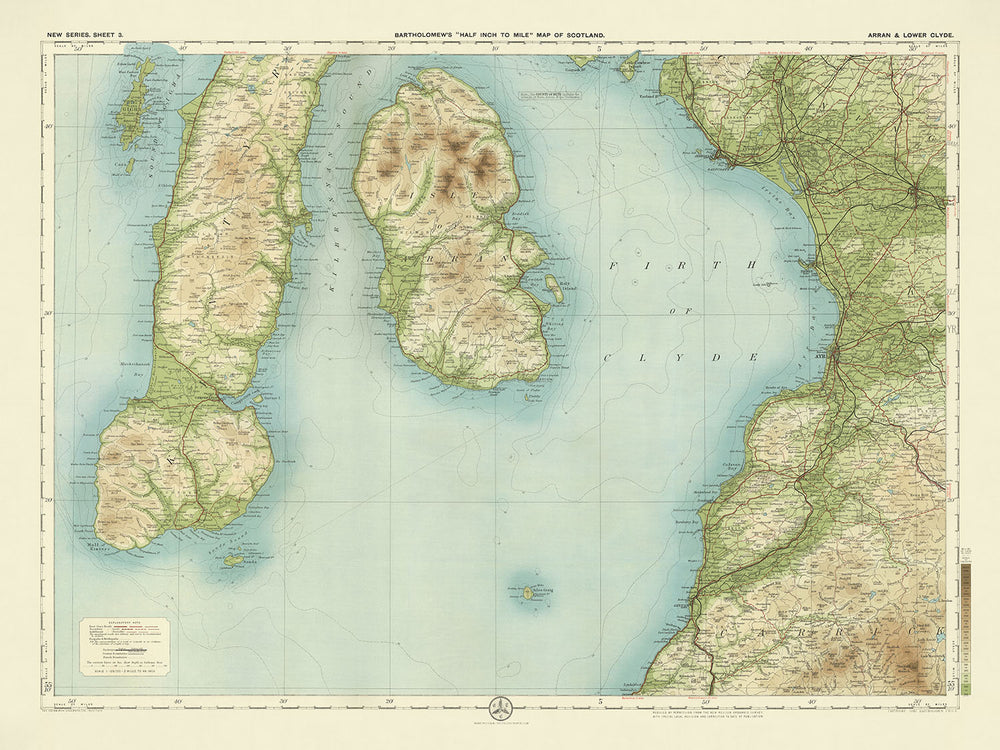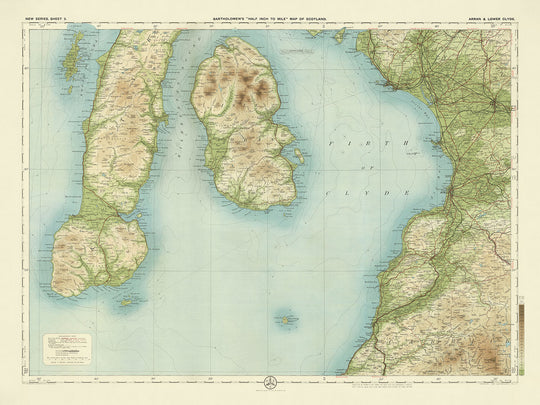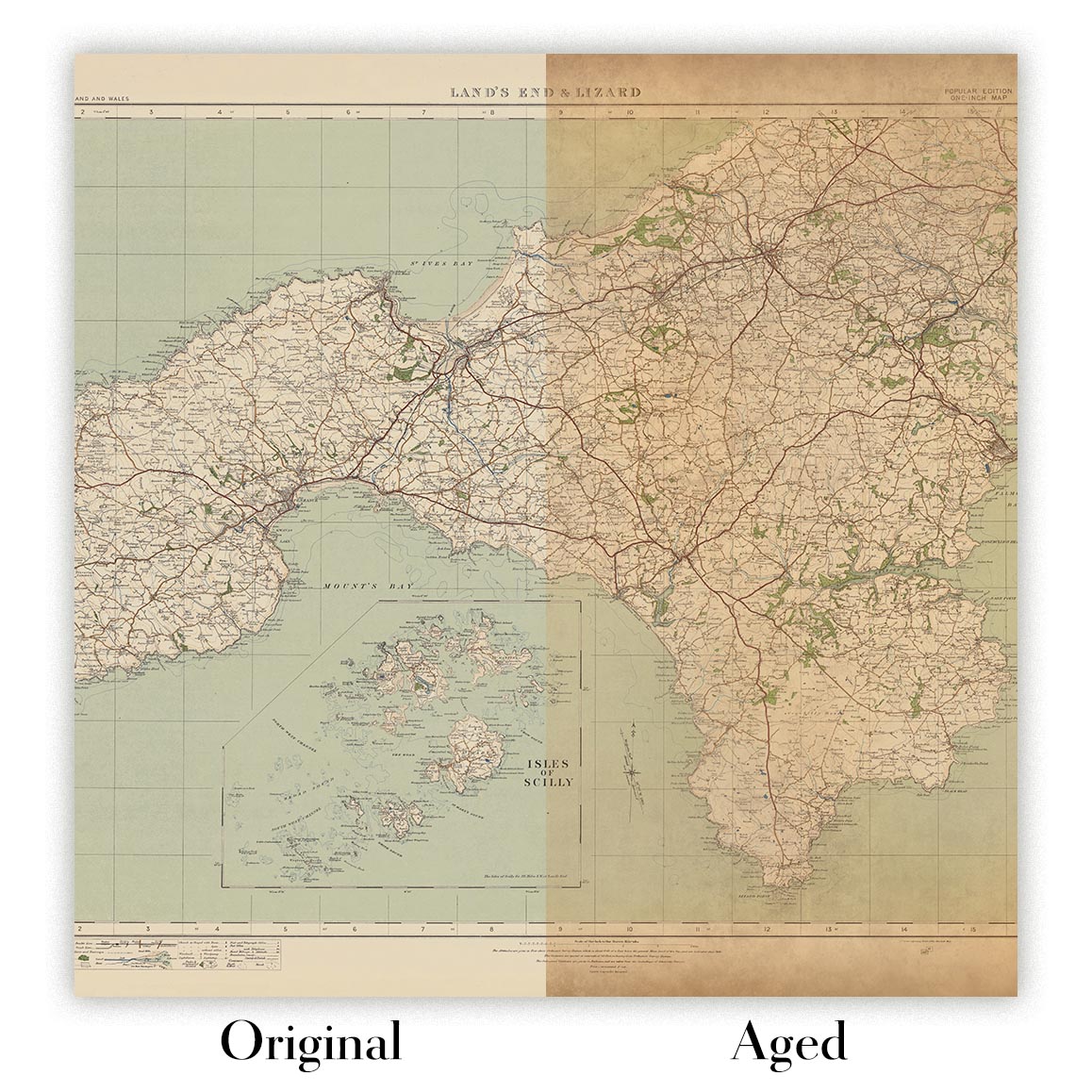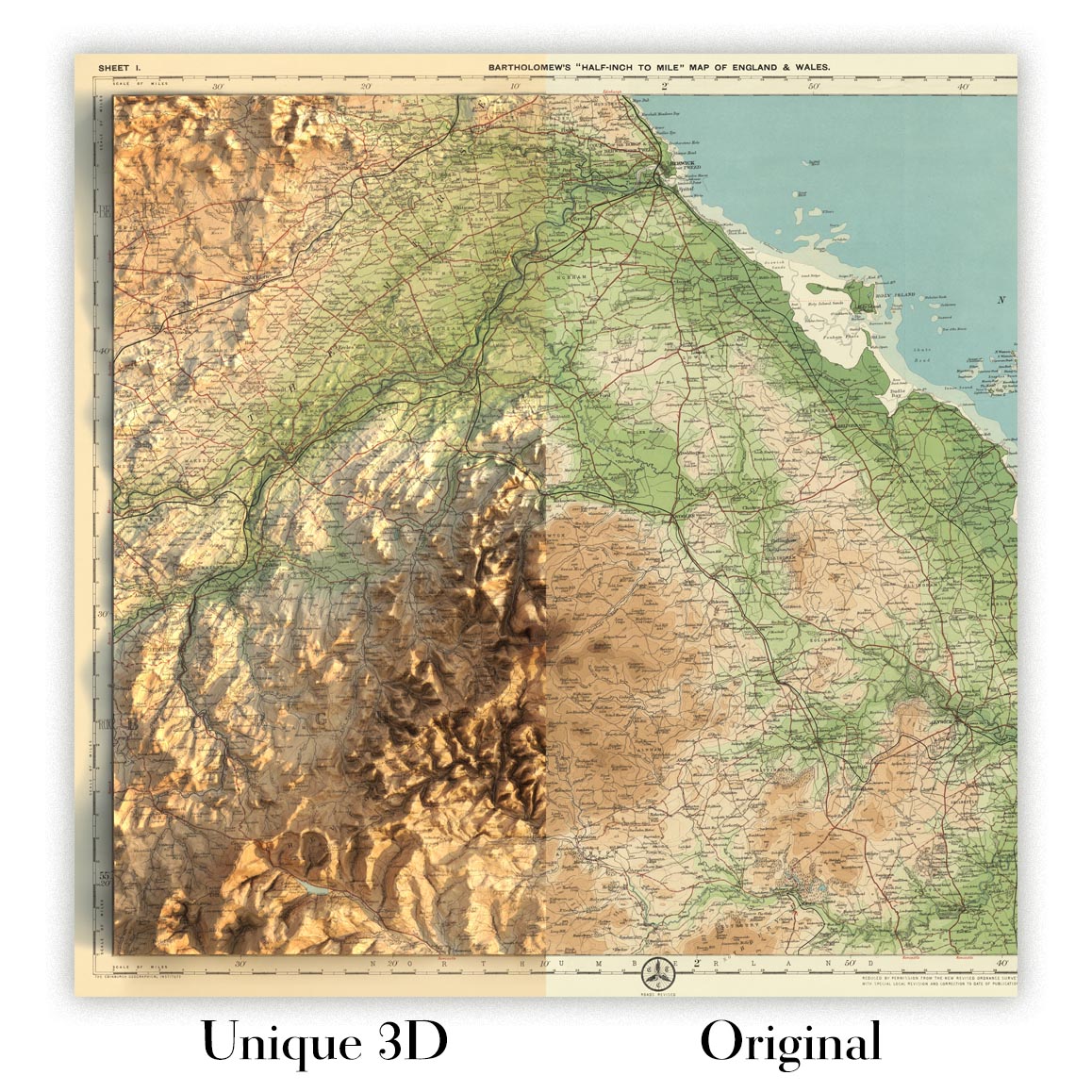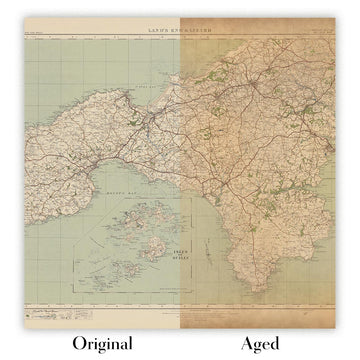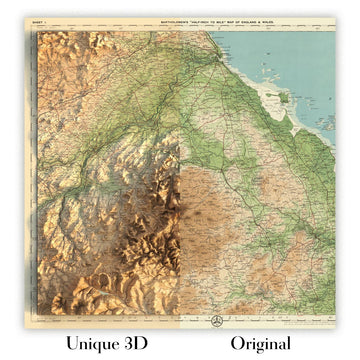- Handmade locally. No import duty or tax
- FREE Delivery by Christmas
- Love it or your money back (90 days)
- Questions? WhatsApp me any time
Own a piece of history
5,000+ 5 star reviews


Sheet 3 - Arran & Lower Clyde, crafted by the illustrious J.G. Bartholomew in 1901, is a masterpiece of cartographic artistry. Known as the "Prince of Cartographers," Bartholomew's meticulous attention to detail and innovative use of color gradients bring the rugged landscapes of the Isle of Arran and the Lower Clyde region to life. This map, with its half-inch to the mile scale, offers a window into the early 20th-century geography of Scotland, capturing the essence of its natural beauty and political boundaries with unparalleled clarity.
Bartholomew's map is celebrated for its distinctive use of color to represent landscape relief. The subtle gradation of hues illustrates the varying elevations, from the rolling hills to the imposing peaks of Goat Fell and Beinn Bharrain. This innovative technique not only enhances the visual appeal but also provides an intuitive understanding of the terrain, making it a favorite among cyclists and tourists of the era. The map's design, based on a reduced Ordnance Survey map, ensures accuracy while showcasing Bartholomew's artistic flair.
The regions depicted in this map are rich in both natural and historical significance. The Isle of Arran, often referred to as "Scotland in miniature," is detailed with its diverse landscapes, from the mountainous north to the gentler southern plains. Notable landmarks such as Brodick Castle and Lochranza Castle are prominently featured, offering a glimpse into the island's storied past. The surrounding waters of the Firth of Clyde and Kilbrannan Sound are meticulously charted, highlighting the vital maritime routes and the strategic importance of these waterways.
The mainland areas of the Lower Clyde region are equally captivating, with towns like Ardrossan, Saltcoats, and Largs depicted in detail. The map traces the intricate network of rivers, including the River Clyde, and the transport routes that connected these communities. The presence of lighthouses, such as those on Pladda and Sanda Island, underscores the region's maritime heritage and the navigational challenges faced by sailors of the time. These features, combined with the lush green expanses and rugged coastlines, paint a vivid picture of early 20th-century Scotland.
Bartholomew's Sheet 3 - Arran & Lower Clyde is more than just a map; it is a historical document that encapsulates the geographical and cultural landscape of its time. Its detailed representation of physical features, political boundaries, and historical landmarks provides invaluable insights into the region's heritage. Whether you are a history enthusiast, a cartography aficionado, or simply someone who appreciates fine craftsmanship, this map is a testament to Bartholomew's legacy and the enduring allure of Scotland's landscapes.
Cities and towns on this map
Isle of Arran:
- Brodick
- Lamlash
- Whiting Bay
- Lochranza
- Blackwaterfoot
- Pirnmill
- Kildonan
- Corrie
Kintyre Peninsula
- Campbeltown
- Carradale
- Mull of Kintyre
- Gigha
Mainland (Lower Clyde):
- Ardrossan
- Saltcoats
- West Kilbride
- Fairlie
- Largs
- Skelmorlie
Notable Features & Landmarks
- Islands:
- Isle of Arran
- Holy Isle
- Pladda
- Sanda Island
- Little Cumbrae
-
Great Cumbrae
-
Bodies of Water:
- Firth of Clyde
-
Kilbrannan Sound
-
Mountains and Hills:
- Goat Fell
- Beinn Bharrain
- Beinn Tarsuinn
- Beinn Nuis
-
Beinn Bhreac
-
Rivers and Streams:
- River Clyde
- Machrie Water
-
Iorsa Water
-
Ferries and Transport Routes:
- Ferry routes between Ardrossan and Brodick
-
Ferry routes between Campbeltown and Arran
-
Lighthouses:
- Pladda Lighthouse
-
Sanda Lighthouse
-
Historic Landmarks:
- Brodick Castle
- Lochranza Castle
Historical and design context
- Name of the Map: Sheet 3 - Arran & Lower Clyde
- Scale: Half-inch to the mile (1:126,720)
- Mapmaker/Publisher: J.G. Bartholomew
- Context about the Mapmaker: J.G. Bartholomew was a renowned Scottish cartographer, often referred to as "the Prince of Cartographers." His work was known for its precision and aesthetic appeal.
- Date of Creation: 1901
- Design and Style:
- Landscape Relief: Uses different layers of color to represent landscape relief, with a subtle and innovative gradation of color bands to show land at different heights.
- Base Map: Based on a reduced Ordnance Survey map from the same period.
- Themes and Topics:
- Political Boundaries: Detailed political boundaries of the regions shown.
- Physical Features: Detailed depiction of physical geography including mountains, valleys, and bodies of water.
- Tourism and Cycling: Popular with cyclists and tourists due to its clear and attractive design.
- Regions Shown:
- Islands: Isle of Arran and parts of the Kintyre Peninsula.
- Mainland: Lower Clyde region of Scotland.
- Historical Significance:
- Tourism: Reflects the growing interest in tourism and outdoor activities such as cycling in the early 20th century.
- Cartographic Innovation: An example of Bartholomew's innovative approach to cartography, particularly in the use of color for landscape relief.
Please double check the images to make sure that a specific town or place is shown on this map. You can also get in touch and ask us to check the map for you.
This map looks great at every size, but I always recommend going for a larger size if you have space. That way you can easily make out all of the details.
This map looks amazing at sizes all the way up to 70in (180cm). If you are looking for a larger map, please get in touch.
Please note: the labels on this map are hard to read if you order a map that is 20in (50cm) or smaller. The map is still very attractive, but if you would like to read the map easily, please buy a larger size.
The model in the listing images is holding the 18x24in (45x60cm) version of this map.
The fifth listing image shows an example of my map personalisation service.
If you’re looking for something slightly different, check out my collection of the best old maps to see if something else catches your eye.
Please contact me to check if a certain location, landmark or feature is shown on this map.
This would make a wonderful birthday, Christmas, Father's Day, work leaving, anniversary or housewarming gift for someone from the areas covered by this map.
This map is available as a giclée print on acid free archival matte paper, or you can buy it framed. The frame is a nice, simple black frame that suits most aesthetics. Please get in touch if you'd like a different frame colour or material. My frames are glazed with super-clear museum-grade acrylic (perspex/acrylite), which is significantly less reflective than glass, safer, and will always arrive in perfect condition.
This map is also available as a float framed canvas, sometimes known as a shadow gap framed canvas or canvas floater. The map is printed on artist's cotton canvas and then stretched over a handmade box frame. We then "float" the canvas inside a wooden frame, which is available in a range of colours (black, dark brown, oak, antique gold and white). This is a wonderful way to present a map without glazing in front. See some examples of float framed canvas maps and explore the differences between my different finishes.
For something truly unique, this map is also available in "Unique 3D", our trademarked process that dramatically transforms the map so that it has a wonderful sense of depth. We combine the original map with detailed topography and elevation data, so that mountains and the terrain really "pop". For more info and examples of 3D maps, check my Unique 3D page.
For most orders, delivery time is about 3 working days. Personalised and customised products take longer, as I have to do the personalisation and send it to you for approval, which usually takes 1 or 2 days.
Please note that very large framed orders usually take longer to make and deliver.
If you need your order to arrive by a certain date, please contact me before you order so that we can find the best way of making sure you get your order in time.
I print and frame maps and artwork in 23 countries around the world. This means your order will be made locally, which cuts down on delivery time and ensures that it won't be damaged during delivery. You'll never pay customs or import duty, and we'll put less CO2 into the air.
All of my maps and art prints are well packaged and sent in a rugged tube if unframed, or surrounded by foam if framed.
I try to send out all orders within 1 or 2 days of receiving your order, though some products (like face masks, mugs and tote bags) can take longer to make.
If you select Express Delivery at checkout your order we will prioritise your order and send it out by 1-day courier (Fedex, DHL, UPS, Parcelforce).
Next Day delivery is also available in some countries (US, UK, Singapore, UAE) but please try to order early in the day so that we can get it sent out on time.
My standard frame is a gallery style black ash hardwood frame. It is simple and quite modern looking. My standard frame is around 20mm (0.8in) wide.
I use super-clear acrylic (perspex/acrylite) for the frame glass. It's lighter and safer than glass - and it looks better, as the reflectivity is lower.
Six standard frame colours are available for free (black, dark brown, dark grey, oak, white and antique gold). Custom framing and mounting/matting is available if you're looking for something else.
Most maps, art and illustrations are also available as a framed canvas. We use matte (not shiny) cotton canvas, stretch it over a sustainably sourced box wood frame, and then 'float' the piece within a wood frame. The end result is quite beautiful, and there's no glazing to get in the way.
All frames are provided "ready to hang", with either a string or brackets on the back. Very large frames will have heavy duty hanging plates and/or a mounting baton. If you have any questions, please get in touch.
See some examples of my framed maps and framed canvas maps.
Alternatively, I can also supply old maps and artwork on canvas, foam board, cotton rag and other materials.
If you want to frame your map or artwork yourself, please read my size guide first.
My maps are extremely high quality reproductions of original maps.
I source original, rare maps from libraries, auction houses and private collections around the world, restore them at my London workshop, and then use specialist giclée inks and printers to create beautiful maps that look even better than the original.
My maps are printed on acid-free archival matte (not glossy) paper that feels very high quality and almost like card. In technical terms the paper weight/thickness is 10mil/200gsm. It's perfect for framing.
I print with Epson ultrachrome giclée UV fade resistant pigment inks - some of the best inks you can find.
I can also make maps on canvas, cotton rag and other exotic materials.
Learn more about The Unique Maps Co.
Map personalisation
If you're looking for the perfect anniversary or housewarming gift, I can personalise your map to make it truly unique. For example, I can add a short message, or highlight an important location, or add your family's coat of arms.
The options are almost infinite. Please see my map personalisation page for some wonderful examples of what's possible.
To order a personalised map, select "personalise your map" before adding it to your basket.
Get in touch if you're looking for more complex customisations and personalisations.
Map ageing
I have been asked hundreds of times over the years by customers if they could buy a map that looks even older.
Well, now you can, by selecting Aged before you add a map to your basket.
All the product photos you see on this page show the map in its Original form. This is what the map looks like today.
If you select Aged, I will age your map by hand, using a special and unique process developed through years of studying old maps, talking to researchers to understand the chemistry of aging paper, and of course... lots of practice!
If you're unsure, stick to the Original colour of the map. If you want something a bit darker and older looking, go for Aged.
If you are not happy with your order for any reason, contact me and I'll get it fixed ASAP, free of charge. Please see my returns and refund policy for more information.
I am very confident you will like your restored map or art print. I have been doing this since 1984. I'm a 5-star Etsy seller. I have sold tens of thousands of maps and art prints and have over 5,000 real 5-star reviews. My work has been featured in interior design magazines, on the BBC, and on the walls of dozens of 5-star hotels.
I use a unique process to restore maps and artwork that is massively time consuming and labour intensive. Hunting down the original maps and illustrations can take months. I use state of the art and eye-wateringly expensive technology to scan and restore them. As a result, I guarantee my maps and art prints are a cut above the rest. I stand by my products and will always make sure you're 100% happy with what you receive.
Almost all of my maps and art prints look amazing at large sizes (200cm, 6.5ft+) and I can frame and deliver them to you as well, via special oversized courier. Contact me to discuss your specific needs.
Or try searching for something!









